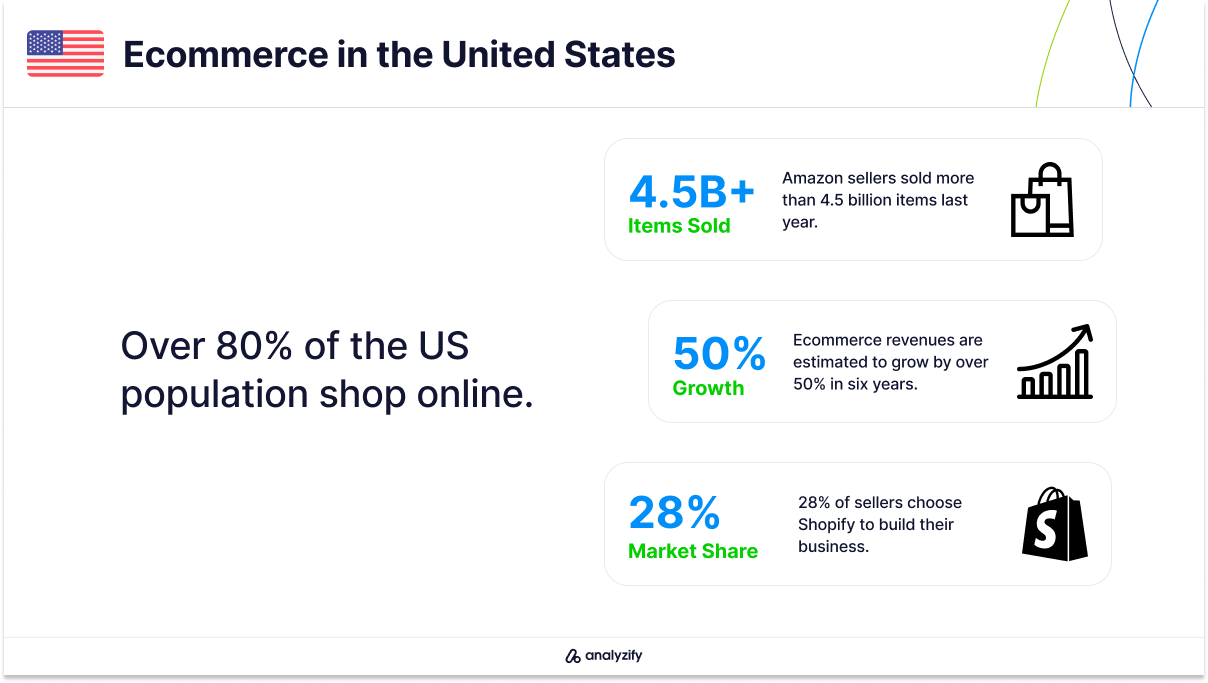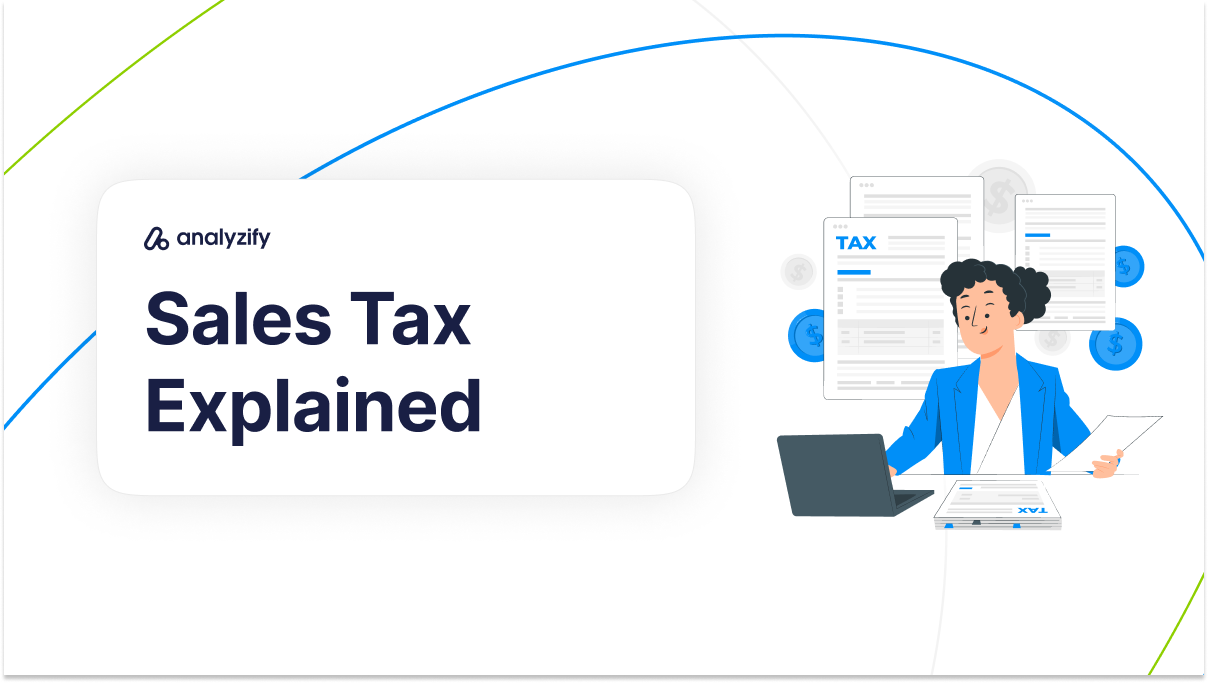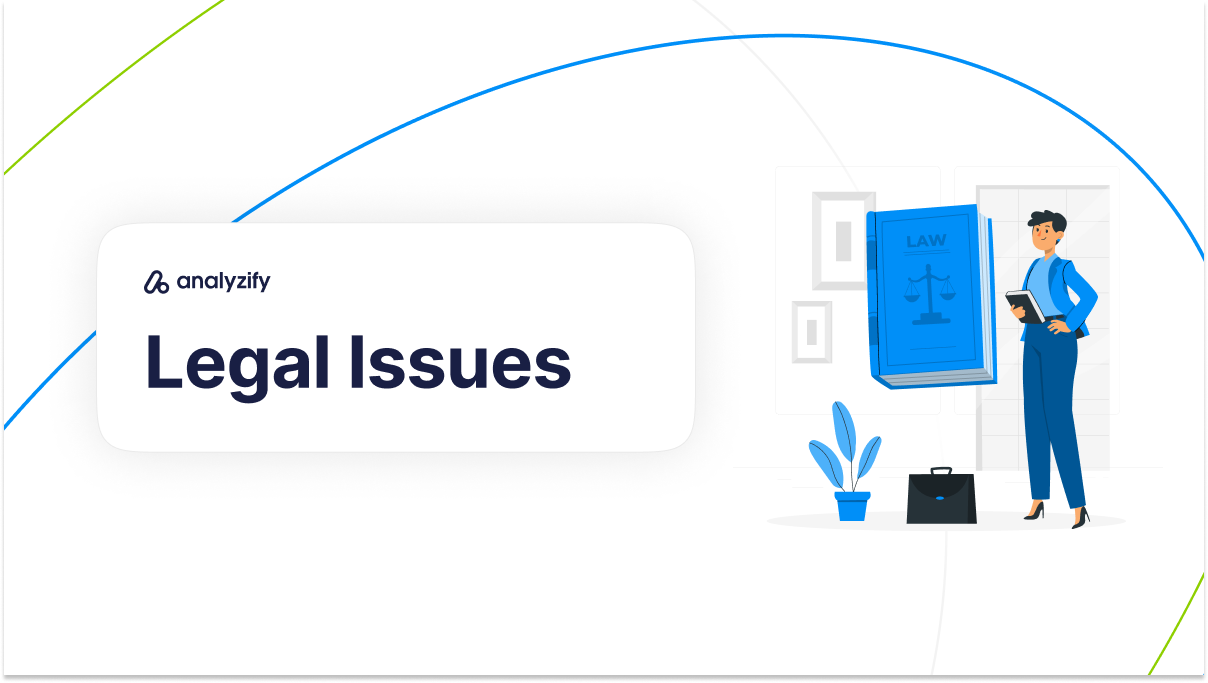In 2025, the US ecommerce market is forecasted to reach over $1 billion in revenue.
What’s more, over 315 million people in the US are expected to shop online by 2028.

As also seen in the latest US ecommerce statistics, the industry is on the rise, with thousands of merchants starting their ecommerce business every year.
If you’re venturing into this booming market, you need to manage your sales tax meticulously.
Here we share all about the sales tax for ecommerce in the US, covering:
- Key points
- What you should do
- Legal issues
and more to simplify this relatively complex topic so you can avoid any potential pitfalls.
Everything You Need to Know about Sales Tax for Ecommerce

Navigating the sales tax in the US requires an understanding of how sales taxes are structured and implemented at the state level.
Unlike many countries that have a national sales tax or value-added tax (VAT), the US allows each state to enact its own sales tax laws.
Before getting more details about each state, let’s get started with what you need to know & do about sales tax in the United States.
Basics of Ecommerce Sales Tax in the US
Here’s a breakdown of key points to help you navigate the sales tax for ecommerce in the US:
What is Sales Tax?
Also often referred to as “online sales tax”, “ecommerce sales tax,” or “internet sales tax”, it is collected on sales made online, similar to sales tax collected in physical stores.
Understanding Physical and Economic Nexus
Nexus refers to the connection between your business and a state or local jurisdiction, which obligates you to collect & remit sales tax on behalf of that jurisdiction.
This connection can be established in two main ways:
Physical Nexus: This is established through your business’s physical presence, such as an office, employee locations, inventory storage (like FBA warehouses), or leased properties in a state. If your business has a physical presence in a state, you need to register and collect sales tax from day one.
Economic Nexus: Introduced in June 2018, this pertains to your sales activities. If your sales in a state exceed a certain threshold (which is shared state by state below), you establish an economic nexus. This requires you to start collecting sales tax only after surpassing this threshold, without retrospective liability.
Checking Your Product Taxability
Not all products are taxable.
Common exemptions include groceries and prescription medications, but these vary widely from one state to another.
Before registering for sales tax for ecommerce, verify whether your products are taxable in the states where you have nexus.
If your products are exempt, even passing the economic nexus threshold doesn’t obligate you to collect sales tax.
Your Sales Volume
You should regularly review your sales by state (quarterly, for instance) to determine if you’ve passed the economic nexus threshold.
Tools and reports from ecommerce platforms like Shopify can help in this analysis.
Sales Tax Rates
Sales tax rates can include state, county, and local levels and vary by your customer’s location. You need to apply the correct tax rate based on the delivery address of the customer.
Marketplace Facilitator Legislation
If you sell through marketplace facilitators like Amazon, Etsy, or eBay, these platforms might collect and remit sales tax on your behalf.
It’s crucial to understand the extent of this coverage to ensure compliance.
Registration and Compliance
If you determine that you have a tax obligation due to economic nexus and your products are taxable (and you’re not covered by a marketplace facilitator for those sales), you’ll need to register for sales tax in the respective state and begin the process of collection and remittance.
Economic Nexus for Sales Tax in the US: State by State
The online sales tax in the US is administered at the state level. Therefore, tax regulations vary widely across the country in the United States.
When your business exceeds certain sales or transaction thresholds in a state, it triggers economic nexus.
Once your business hits this threshold in any given year, you are required to collect sales tax from that point onwards for your sales in that state.
It’s important to note that this threshold resets annually, so you need to monitor your sales each year to determine if you meet the criteria again.
Here’s a full list of economic nexus thresholds (state by state) for sales tax in the US:
| State | Economic Nexus Threshold |
| Alabama | $250,000 in sales |
| Alaska | Local thresholds may apply (No state sales tax) |
| Arizona | $100,000 in sales |
| Arkansas | $100,000 in sales or 200 transactions |
| California | $500,000 in sales |
| Colorado | $100,000 in sales |
| Connecticut | $100,000 in sales and 200 transactions |
| Florida | $100,000 in sales |
| Georgia | $100,000 in sales or 200 transactions |
| Hawaii | $100,000 in sales or 200 transactions |
| Idaho | $100,000 in sales |
| Illinois | $100,000 in sales or 200 transactions |
| Indiana | $100,000 in sales or 200 transactions |
| Iowa | $100,000 in sales |
| Kansas | $100,000 in sales |
| Kentucky | $100,000 in sales or 200 transactions |
| Louisiana | $100,000 in sales or 200 transactions |
| Maine | $100,000 in sales |
| Maryland | $100,000 in sales or 200 transactions |
| Massachusetts | $100,000 in sales |
| Michigan | $100,000 in sales |
| Minnesota | $100,000 in sales or 200 transactions |
| Mississippi | $250,000 in sales |
| Missouri | $100,000 in sales |
| Nebraska | $100,000 in sales or 200 transactions |
| Nevada | $100,000 in sales or 200 transactions |
| New Jersey | $100,000 in sales or 200 transactions |
| New Mexico | $100,000 in sales |
| New York | $500,000 in sales and 100 transactions |
| North Carolina | $100,000 in sales or 200 transactions |
| North Dakota | $100,000 in sales or 200 transactions |
| Ohio | $100,000 in sales or 200 transactions |
| Oklahoma | $100,000 in sales |
| Pennsylvania | $100,000 in sales |
| Rhode Island | $100,000 in sales or 200 transactions |
| South Carolina | $100,000 in sales |
| South Dakota | $100,000 in sales or 200 transactions |
| Tennessee | $500,000 in sales |
| Texas | $500,000 in sales |
| Utah | $100,000 in sales or 200 transactions |
| Vermont | $100,000 in sales or 200 transactions |
| Virginia | $100,000 in sales or 200 transactions |
| Washington | $100,000 in sales |
| West Virginia | $100,000 in sales or 200 transactions |
| Wisconsin | $100,000 in sales or 200 transactions |
| Wyoming | $100,000 in sales or 200 transactions |
6 Steps to Stay Tax-Compliant For Online Sellers in the US

Here is a quick guide on what you need to do about sales tax if you are an online seller in the United States:
1. Initial Setup and Registration
- Physical Nexus: Immediately register for sales tax permits in states where you have a physical presence, such as offices, warehouses, or employees.
- Sales Tax Permits: If you establish any form of nexus, including economic, register with that state’s taxing authority before you begin collecting sales tax from customers.
2. Understanding and Monitoring Nexus
- Economic Nexus: See the economic nexus laws in each state where you do business. Monitor your sales annually to see if you meet the thresholds that require you to collect and remit sales tax, typically $100,000 in sales or 200 transactions.
- Marketplace Facilitator Laws: Determine if you sell through marketplaces like Amazon or Etsy, as these platforms may collect and remit sales tax on your behalf.
3. Tax Collection and Compliance
- Collecting Sales Tax: Ensure you use the correct sales tax rates, which can vary by state, county, and city.
- Filing and Payment: Understand each state’s filing frequency and deadlines (monthly, quarterly, annually) to avoid penalties and interest. File sales tax returns and make payments on time.
4. Record Keeping
- Maintain detailed records of all transactions, including amounts of sales tax collected and the locations of your customers. Good record-keeping is crucial for audits and resolving any discrepancies with tax authorities.
5. Automation and Professional Help
- Automation Tools: Consider using sales tax automation software if your platform does not provide this service. This can help in calculating the correct tax rates, managing tax documents, and filing returns.
- Consulting Tax Professionals: For complex situations or significant business operations, seek advice from tax professionals to navigate the intricacies of ecommerce sales tax effectively.
6. Stay Informed
- Keep up with changes in sales tax laws and rates. Regular updates from professional sources or consultations with tax experts can help you stay compliant with new regulations or changes in existing laws.
By integrating these practices into your business operations, you can manage your sales tax obligations more effectively, ensuring compliance and minimizing the risk of legal complications.
This proactive approach not only helps you avoid legal issues but also supports the smooth operation of your business as it grows.
Potential Legal Issues for Sales Tax Mismanagement

Mismanagement of online sales tax carries significant risks, as you are directly responsible for collecting and remitting sales tax as an online seller in the US.
If you fail to collect the necessary sales tax from customers, you will be required to cover it from your own funds. The consequences of online sales tax mismanagement include:
- Late Fees: Late fees for delinquent tax payments can be as high as 10% of the owed amount, increasing the financial burden on your business.
- Interest: Outstanding taxes are typically subject to interest, which accrues until the full owed amount is paid.
- Collection Fees: Additional fees may be incurred if the state has to take action to collect overdue taxes.
- Legal Consequences: In some states, severe cases of tax evasion or repeated failure to comply with tax obligations can lead to criminal charges, potentially resulting in jail time.
To minimize these risks, it’s crucial to maintain a rigorous system for tax collection and remittance.
Staying organized, using automated tax compliance tools, and regularly reviewing your tax practices against current laws can help prevent these issues.
This proactive approach not only helps with tax compliance but also protects the financial health and reputation of your business.
Frequently Asked Questions: Sales Tax in the US
Here are the most common questions about the sales tax for ecommerce in the US:
What is sales tax?
Sales tax, often referred to as “online sales tax,” “ecommerce sales tax,” or “internet sales tax,” is a tax applied to sales made online, similar to the tax collected in physical stores.
What is a nexus, and why is it important?
A nexus is a connection between your business and a state or local jurisdiction that requires you to collect and remit sales tax on their behalf. This connection can be physical (such as an office, employees, or inventory) or economic (based on sales activities).
How do I know if I have a physical nexus?
You have a physical nexus if your business has a tangible presence in a state, like an office, employee locations, inventory storage, or leased properties. Registration for sales tax in these states is required from the outset.
What is economic nexus?
Introduced in June 2018, economic nexus is triggered by your sales activities. If your annual sales in a state exceed certain thresholds, typically $100,000 in sales or 200 transactions, you establish an economic nexus and must start collecting sales tax from that point onwards.
How can I manage sales tax as a Shopify seller?
If managing sales tax becomes complex, you can consider using apps available on the Shopify app store like Avalara, TaxJar, or Quaderno. These services can automate much of the sales tax calculation, collection, and filing process.
Are all products taxable?
Not all products are taxable. Common exemptions include groceries and prescription medications, but exemptions can vary widely from state to state. It’s important to verify the taxability of your products in the states where you have nexus.
What should I do if I sell through a marketplace facilitator?
If you sell through marketplace facilitators like Amazon, Etsy, or eBay, these platforms might collect and remit sales tax on your behalf. It’s crucial to understand the extent of this coverage to ensure compliance.
How do I handle sales tax collection and compliance?
Ensure you use the correct sales tax rates, which can vary by state, county, and city. Utilize automation tools to calculate the correct tax rates and manage tax documents. Regularly file and make tax payments on time to avoid penalties and interest.
How should I keep records?
Maintain detailed records of all transactions, including the amounts of sales tax collected and the locations of your customers. Good record-keeping practices are essential for audits and resolving discrepancies with tax authorities.
What are the potential legal issues for sales tax mismanagement?
Mismanagement of sales tax can lead to late fees, interest charges, collection fees, and even criminal charges in severe cases. It’s vital to stay organized and use automated tools to manage your tax obligations efficiently.
What steps should I take if I exceed the economic nexus threshold?
If you exceed the economic nexus threshold, you should first determine if your products are taxable and whether you’re selling through a marketplace facilitator. If necessary, register for sales tax in the affected states and begin collecting and remitting sales tax.
Conclusion
Navigating the complexities of sales tax in the growing US ecommerce landscape requires diligence and a proactive approach.
As the market continues to grow, understanding and complying with sales tax regulations across various states becomes not just a necessity but a crucial aspect of maintaining your business’s integrity and financial health.
By staying informed, utilizing the right tools, and regularly reviewing your sales activities, you can ensure compliance and focus on expanding your enterprise without the looming concerns of tax mismanagement.

































